The Big Five of Kruger Park
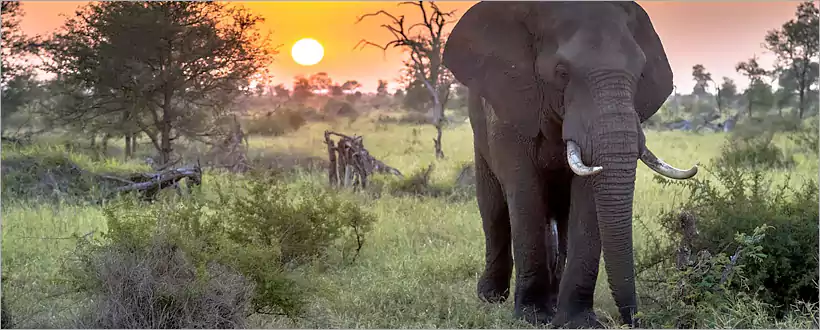
Kruger National Park - the Legendary Big Five
Kruger Park - the Legendary Big Five
The Big 5 wildlife refers to the Lion, Leopard, Rhino, Elephant and Buffalo. These are often the most in-demand animals to see while on an African safari.
The term “Big Five” originally coined in the 1800's by big-game hunters, referred to the difficulty in hunting the lion, leopard, rhino, elephant and African buffalo. These five large African mammal species were known to be dangerous and it was considered a feat by trophy hunters to bring them home.
Today, however, the expression takes on a gentler form, referring to seeing and photographing the Big Five - not shooting them - during wildlife safaris on the African continent.
The lion and leopard are the predators of the bunch, who hunt with unmatched grace and stealth, while the majestic elephant is larger than life with gleaming tusks and a large trunk. The buffalo is the unruly, unpredictable herbivore that can usually be seen with its herd, and the stocky rhino can be found lazily munching on the grass near the dense trees of the Kruger Park.
The Big 5 also makes an appearance on South Africa's currency; they are truly the stars of both the bushveld and the money market. Visitors to Kruger National Park have ample opportunities to spot the beautiful quintuple of African wildlife with daily game drives and walking safaris, run by trained game rangers who will help guests spot the dignified lion, the great elephant, the stubborn buffalo, the sturdy rhino and the elusive leopard.
What is The IUCN Red List?
Established in 1964, The International Union for Conservation of Nature’s Red List of Threatened Species has evolved to become the world’s most comprehensive information source on the global conservation status of animal, fungi and plant species.
The IUCN Red List is a critical indicator of the health of the world’s biodiversity. Far more than a list of species and their status, it is a powerful tool to inform and catalyze action for biodiversity conservation and policy change, critical to protecting the natural resources we need to survive. It provides information about range, population size, habitat and ecology, use and/or trade, threats, and conservation actions that will help inform necessary conservation decisions.
The Rhino
The Black Rhino (Diceros bicornis) and the White Rhino (Ceratotherium simum)IUCN Red List: Black Rhino: Critically Endangered
IUCN Red List: White Rhino: Near Threatened
Bulls weigh up to 1 200 Kg and cows about 800 Kg. As such this species is smaller than the White Rhino. It can further be distinguished from the White (or square-lipped) Rhino by the pointed upper-lip. Other than the White Rhino, the smaller head is usually held high. The ears are trumpet-like and more rounded. The soil in which it rolls, partly determines the skin colour.
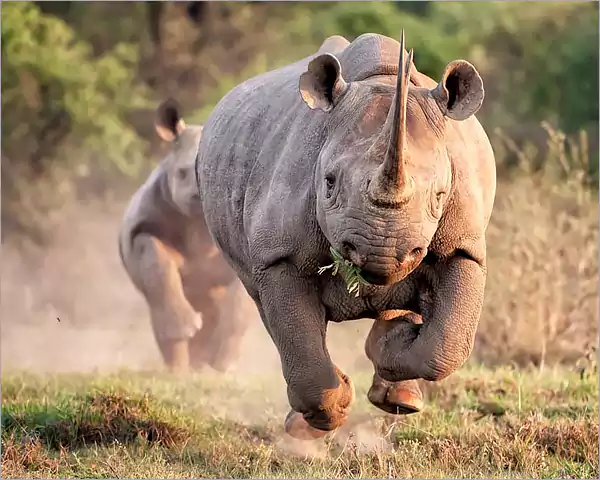 Black Rhino Kruger Park
Black Rhino Kruger Park
Being a browser, it feeds on trees, bushes and herbs. Only when under nutritional stress will it consume grass. Branches and twigs are grabbed with the hooked upper lip, pulled into the mouth, and then sheared off with the molars, and masticated. This 'pruning' of bushes allowed ecologists to conduct detailed studies of feeding patterns and preferences.
Running, it can attain a speed of up to 55 km/h. White Rhino dung middens are sometimes covered by the Black Rhino with it's own dung. Size of bull territories are largely determined by the availability of food and water supply. Young bulls straying into the territories of dominant bulls may be killed. Bulls are solitary, and will only spend time with a female in an oestrus cycle.
The African population declined from about 65 000 in 1970 to a mere 2 400 in 1995, when the last count was conducted. Most of the world's Black Rhino population occurs in South Africa, Namibia, Kenya and Zimbabwe.
The Black Rhino species is now considered to be seriously threatened. Complicating conservation efforts, is the fact that four subspecies are acknowledged within the distribution range of the Black Rhino. Of D.b. bicornis (black rhinoceros, black rhino or hook-lipped rhinoceros (Diceros bicornis)), small populations are re-established in southwestern South Africa, of D.b. michaeli, a trans-located population is established in the Addo Elephant National Park, South Africa. D.b minor occurs in the northern and eastern parts of South Africa.
The rhinos of Africa are in another stage of decimation with the rhino horn trade sky-rocketing, and the price of Rhino Horn becoming more valuable than cocaine. The cause of this is the mistaken belief in the East that the horn is a powerful aphrodisiac and enhancer. The trade is not going to stop until the attitudes are changed in the East, despite the ideas of the general public and conservationists.
The Elephant
The African Elephant (Loxodonta africana)IUCN Red List: Vulnerable
An elephant drinks from a pool in the Mphongolo River that still holds water during winter months. An elephant can draw 17 litres of water at a time. During winter, elephant are usually concentrated within six kilometres of water and drink on average every two days, consuming between 180 and 400 litres per visit.
The elephant with its dexterous trunk, which is composed of 50 000 muscles, is able to carefully select leaves from among the thorny branches of a thicket of Delagoa thorns (Acacia delagoensis).
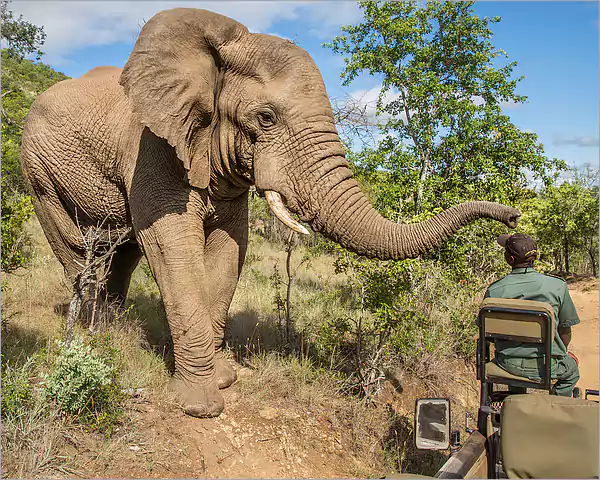 The African elephant - Kruger Park Big 5
The African elephant - Kruger Park Big 5
Elephants are considered a keystone species, meaning they shape and contribute to the larger ecosystem in a way that supports other animals.
These enormous creatures require a lot of space to live and thrive. With human population expansion and development, their habitats are dwindling.
Additionally, a huge threat to elephants is poaching for their ivory tusks. Both male and female elephants grow large tusks for defense and gathering food. Their ivory tusks have long been a symbol commodity of wealth, where people pay lots of money to have ivory items.
The Buffalo
The Cape or African Buffalo (Syncerus caffer)IUCN Red List: Near Threatened
Young buffalo depend on the structure of the herd for protection. Buffalo are almost exclusively grazers, and half the Kruger population occurs on the open savannas of the Central Region.
These bovids consume large quantities of grass of a moderate quality, and in doing so play a valuable role in the ecosystem by reducing tall grasslands and opening up areas for the antelope that feed only on short grasses.
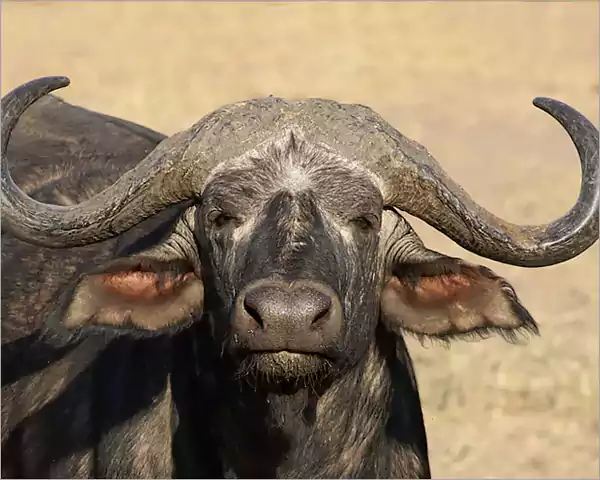 The Cape Buffalo - Kruger Park Big 5
The Cape Buffalo - Kruger Park Big 5
As an adult can weigh more than 750 kilograms, buffalo comprise a quarter of Kruger's total biomass, or live weight of animals. Although lion working together can overpower an adult bull, the availability of sufficient grass is the most important limiting factor on herd size.
Unlike most antelope species, male buffalo voluntarily leave the breeding herd and rejoin at a later stage. A herd does not occupy a fixed territory, and its favoured home range includes certain areas that are utilised during winter, and an expanded range that is used during summer.
Typically, old bulls eventually become permanently separated from the herd to live a solitary existence, or form small bachelor groups.
In winter, buffalo in Kruger National Park concentrate within eight kilometres of permanent water, especially along the Sabie, Olifants, Letaba and Shingwedzi rivers, and the sight of a herd of several hundred buffalo raising clouds of red dust as they trek to water is one of the most memorable that the Park can offer.
A dominant buffalo bull asserts his position by holding his head high while pointing his nose towards the ground. Head-tossing and a hooking motion of the horns are also used. If this fails, the bull will batter his solid horn boss against that of his rival until he gives in.
The Lion
The Lion (Panthera leo)IUCN Red List: Vulnerable
Under favourable conditions, when game concentrates around water holes and there is a steady supply of prey, a lioness can give birth to a litter of one to five cubs every two years. Within a pride most cubs are born at the same time, mostly between February and April when young prey animals are abundant.
Since the establishment of the Park in 1898, lion have increased proportionately to a significant increase in their prey species. In the 1920s Stevenson-Hamilton counted 600 lion in the Park. Today, Kruger supports about 2 000, representing one of the largest populations in Africa.
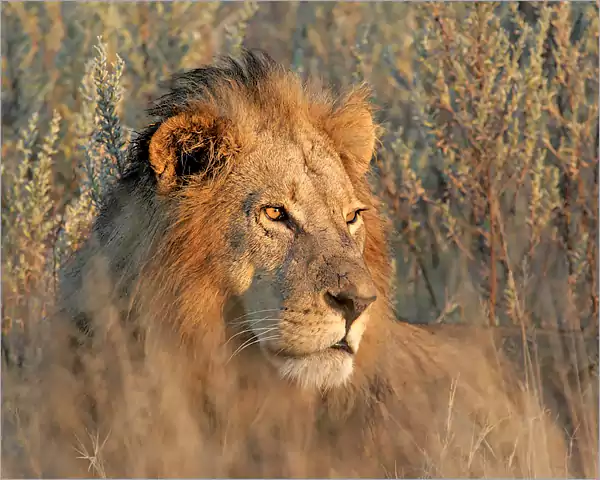 The African lion - Kruger Park Big 5
The African lion - Kruger Park Big 5
The mane of a dominant pride lion protects the head and neck from injury and deters rival males by making the lion appear more formidable. In East Africa the Maasai people have copied this mask, and warriors wear feathered headdresses to appear taller and more menacing.
Lion keep a close watch on descending vultures in the hope of locating a potential meal. Lion are opportunistic predators that will also scavenge food from other predators, and in this instance were able to locate the vultures and the remains of a kill in less than 20 minutes.
Although lion spend much of the day resting, a charging lion dispels any doubts about their strength, speed and agility. Most chases are short and do not exceed 200 metres, but a lion can attain a speed of 60 kilometres an hour in a final burst of speed before bringing down prey.
Play activities within the safety of the pride prepare lion cubs for hunting success in adulthood. Young cubs display a pattern of brown spots and rosettes that is similar to the patterning on the coat of leopard, and may be useful as camouflage.
The Leopard
The Leopard (Panthera pardus)IUCN Red List: Vulnerable
A large male leopard can weigh as much as 70 kilograms, but females are much lighter at about 30 kilograms. Impala comprise 78 per cent of the leopard's diet in Kruger. An adult leopard requires prey equivalent to about 20 impala per year, so leopard predation is not a major limiting factor on impala numbers.
As leopard are primarily nocturnal and active when lion and hyaena are about, these powerful cats have to face strong competition. In the Kruger Park they prey mainly on impala and aggressively defend their kills against rival predators. Essentially ground dwelling, leopard readily climb trees to escape from danger and to store their kills safely out of the reach of other predators.
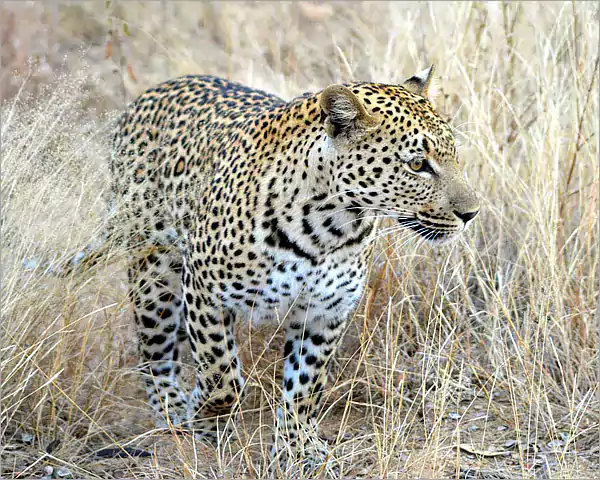 The leopard - Kruger Park Big 5
The leopard - Kruger Park Big 5
Long believed to be very scarce, in the 1970s an American researcher captured a surprising number of leopard within a few kilometres of Skukuza, and the estimate of the total number in the Park was revised to about 1 000. The number is believed to have remained relatively unchanged up to the present. This is because - barring major habitat changes and human interference - leopard populations tend to remain stable, kept in balance by the availability of prey species and the corresponding size of each leopard's territory.
While leopard inhabit all 16 of Kruger's major vegetation types, the highest densities occur in dense riverine bush bordering rivers such as the Sabie and Shingwedzi.
